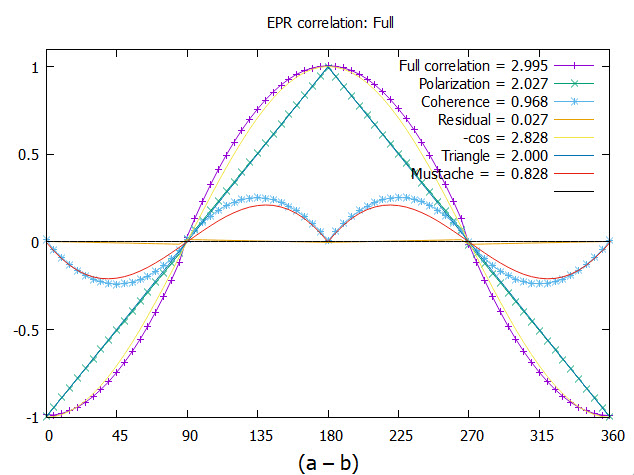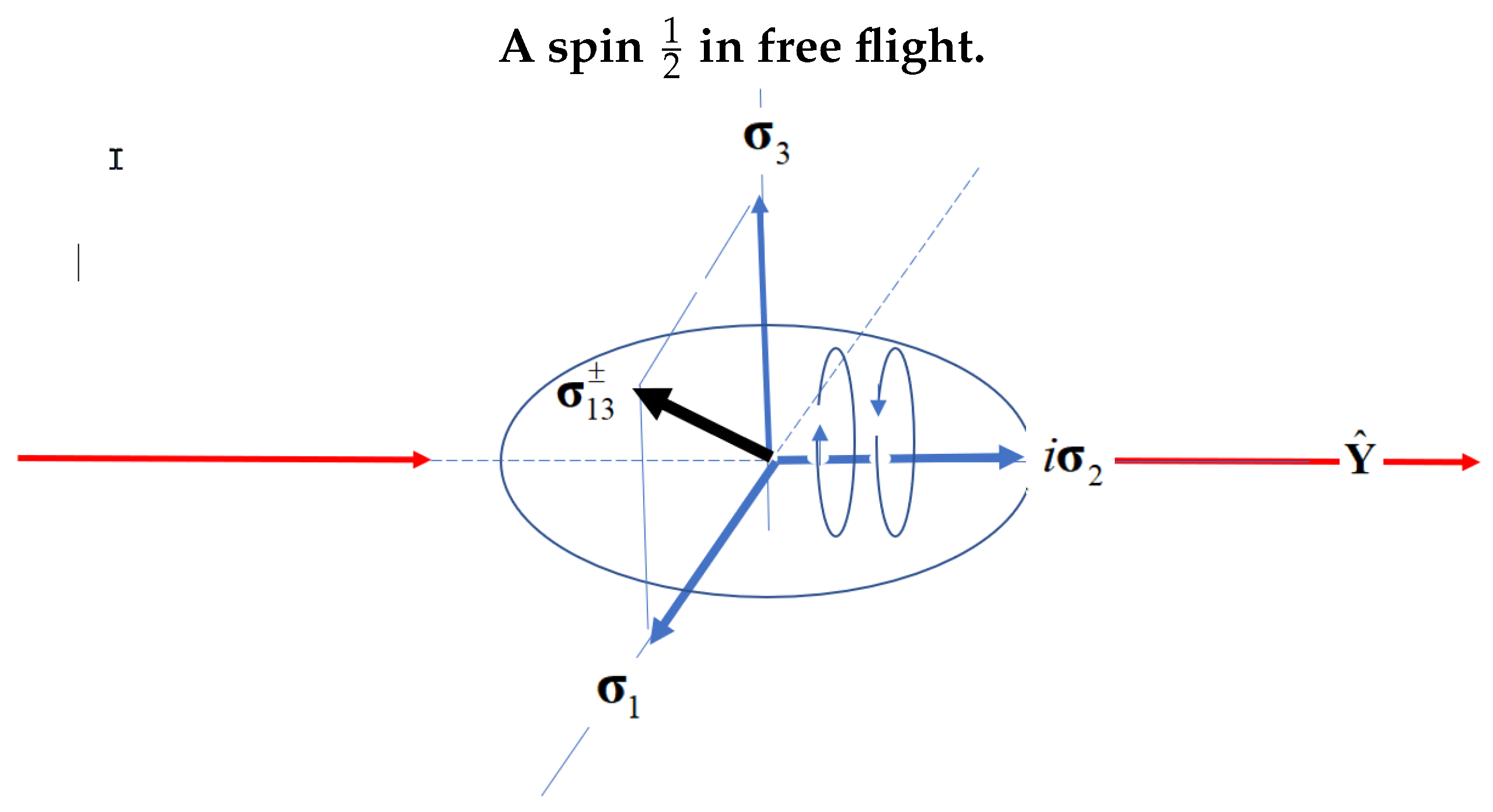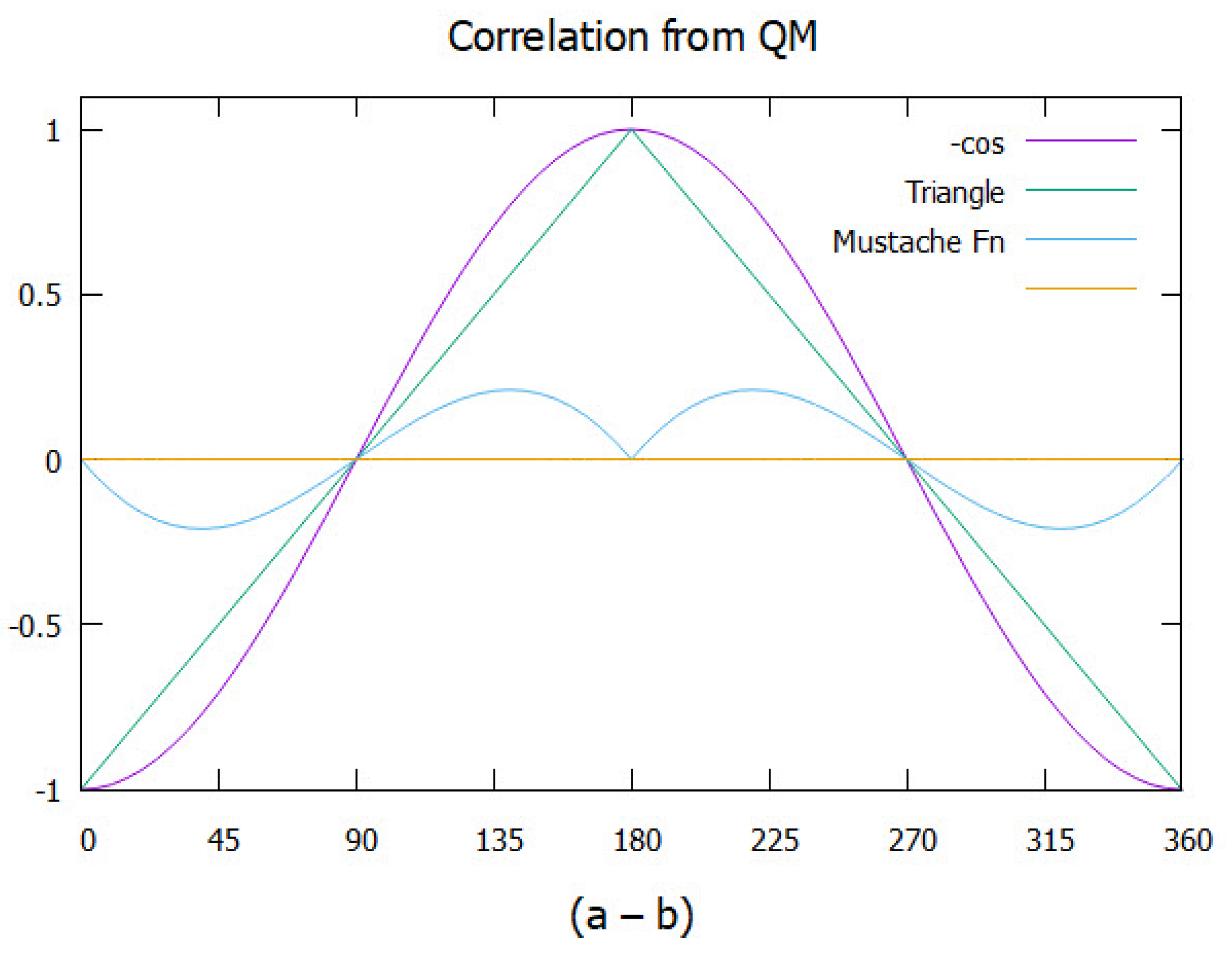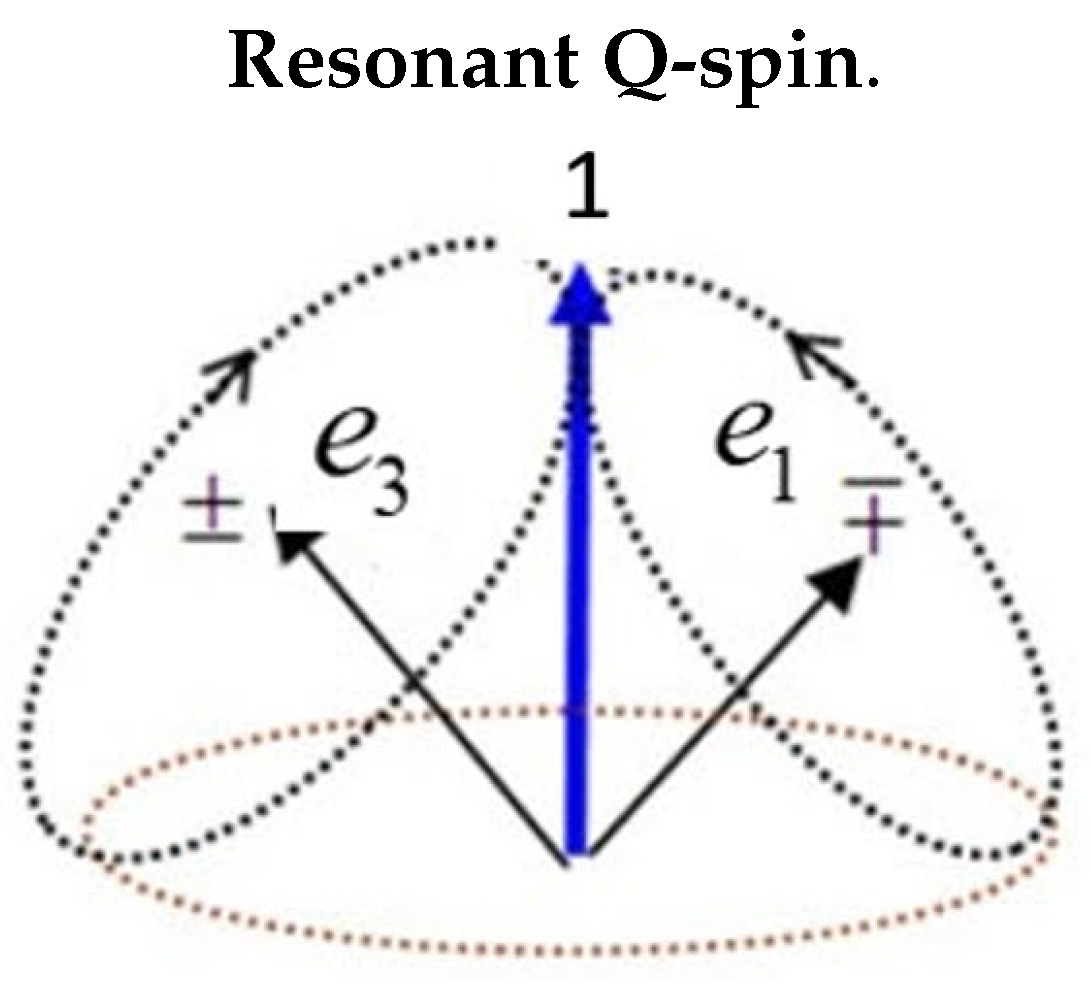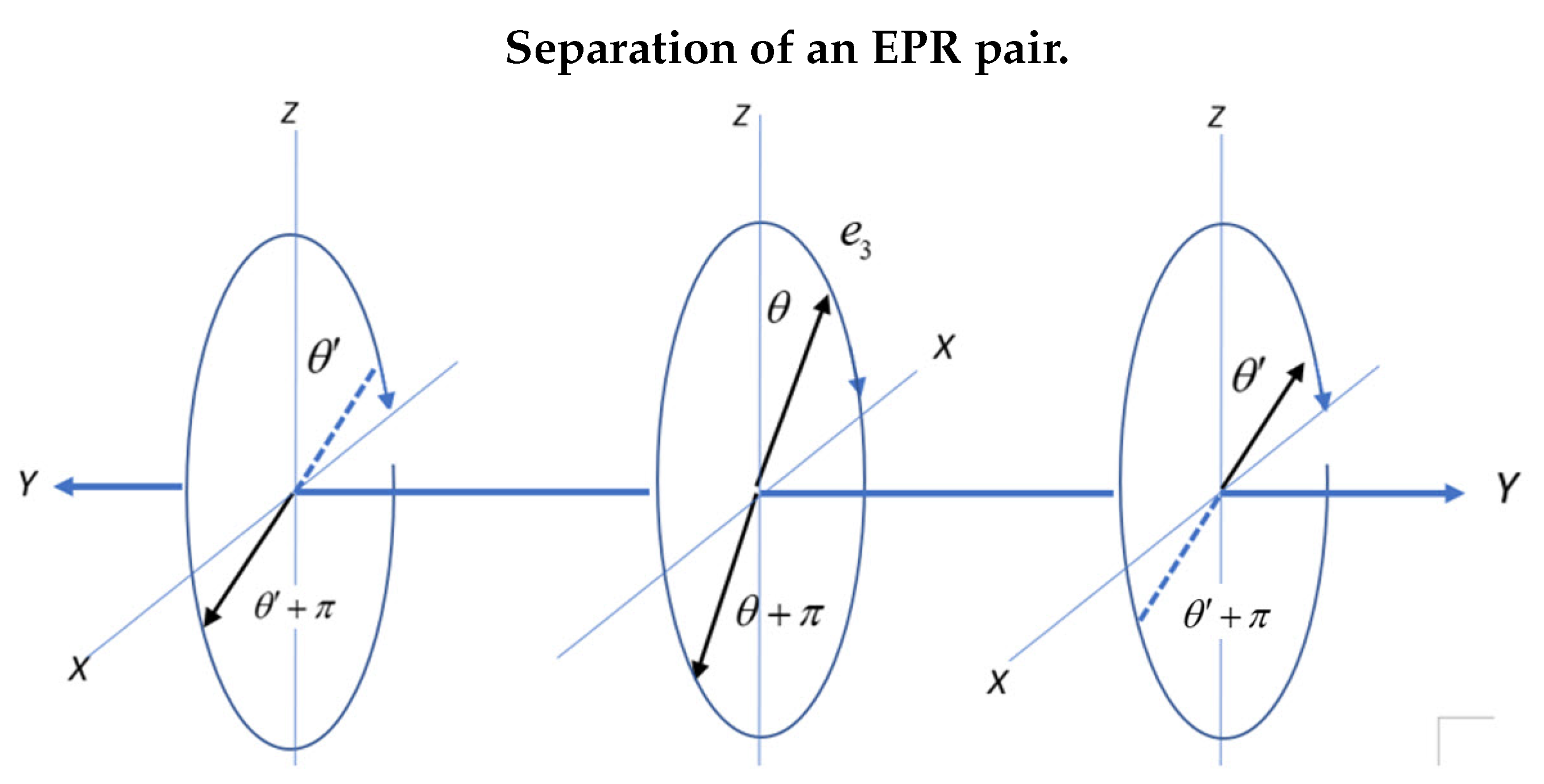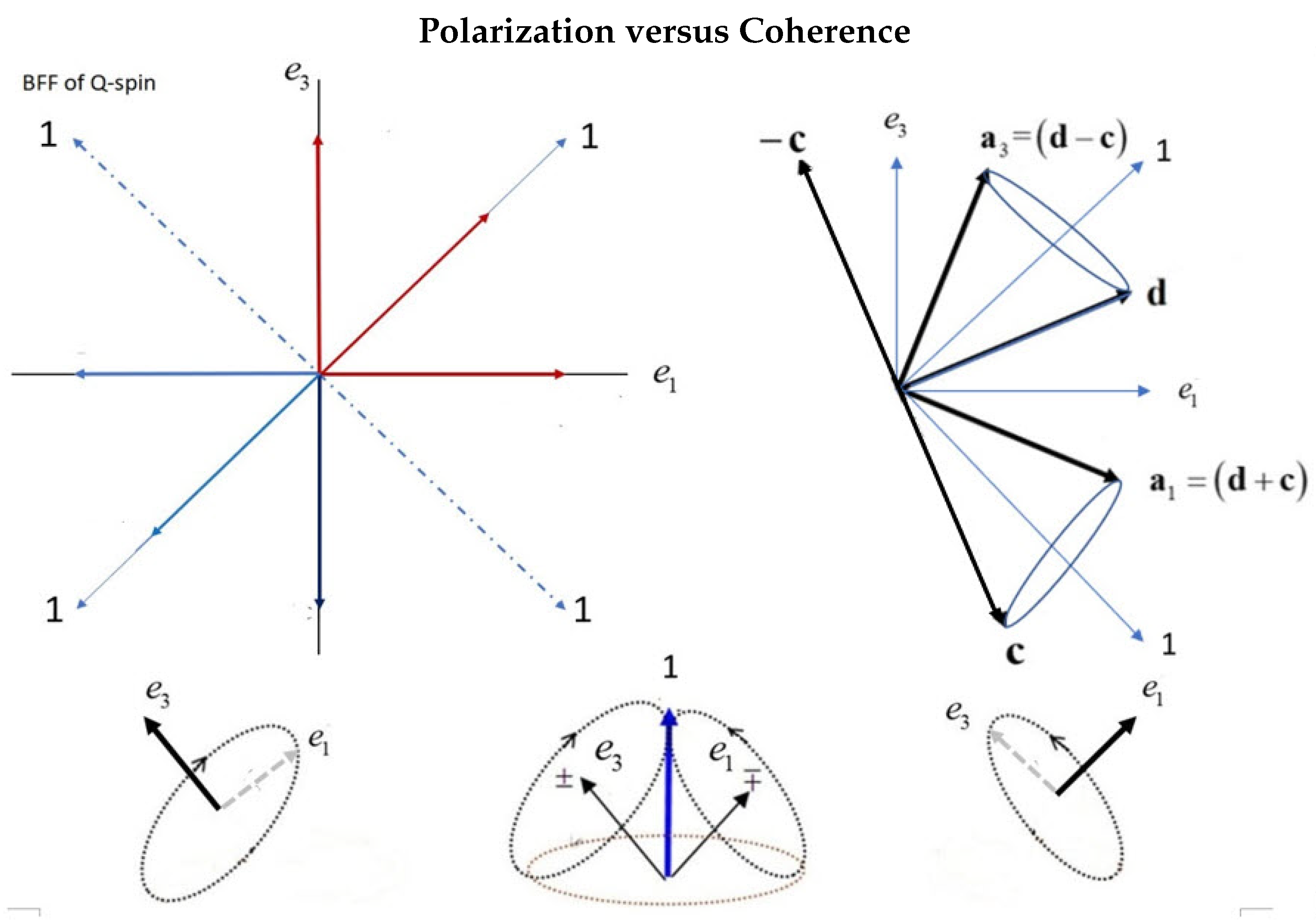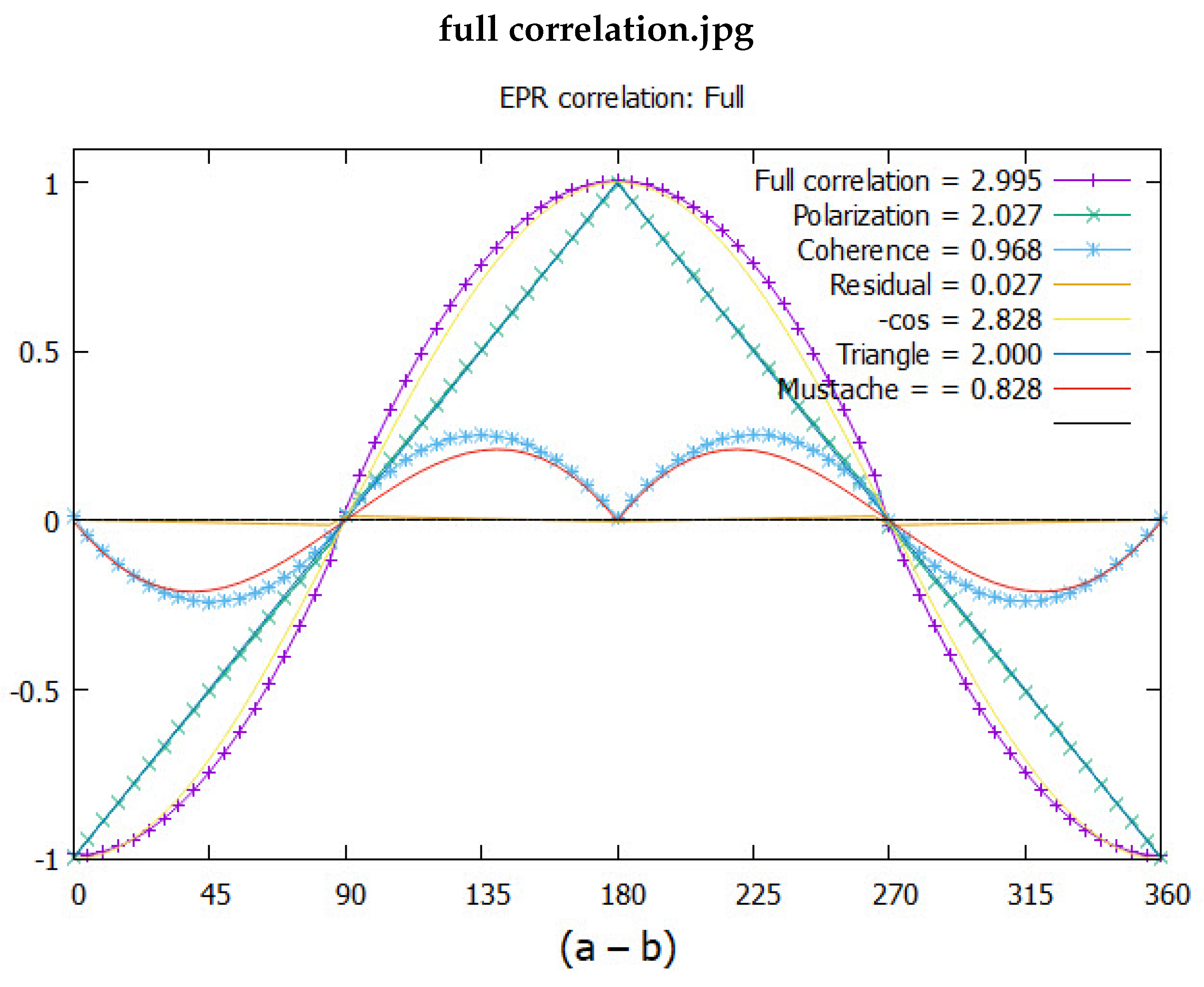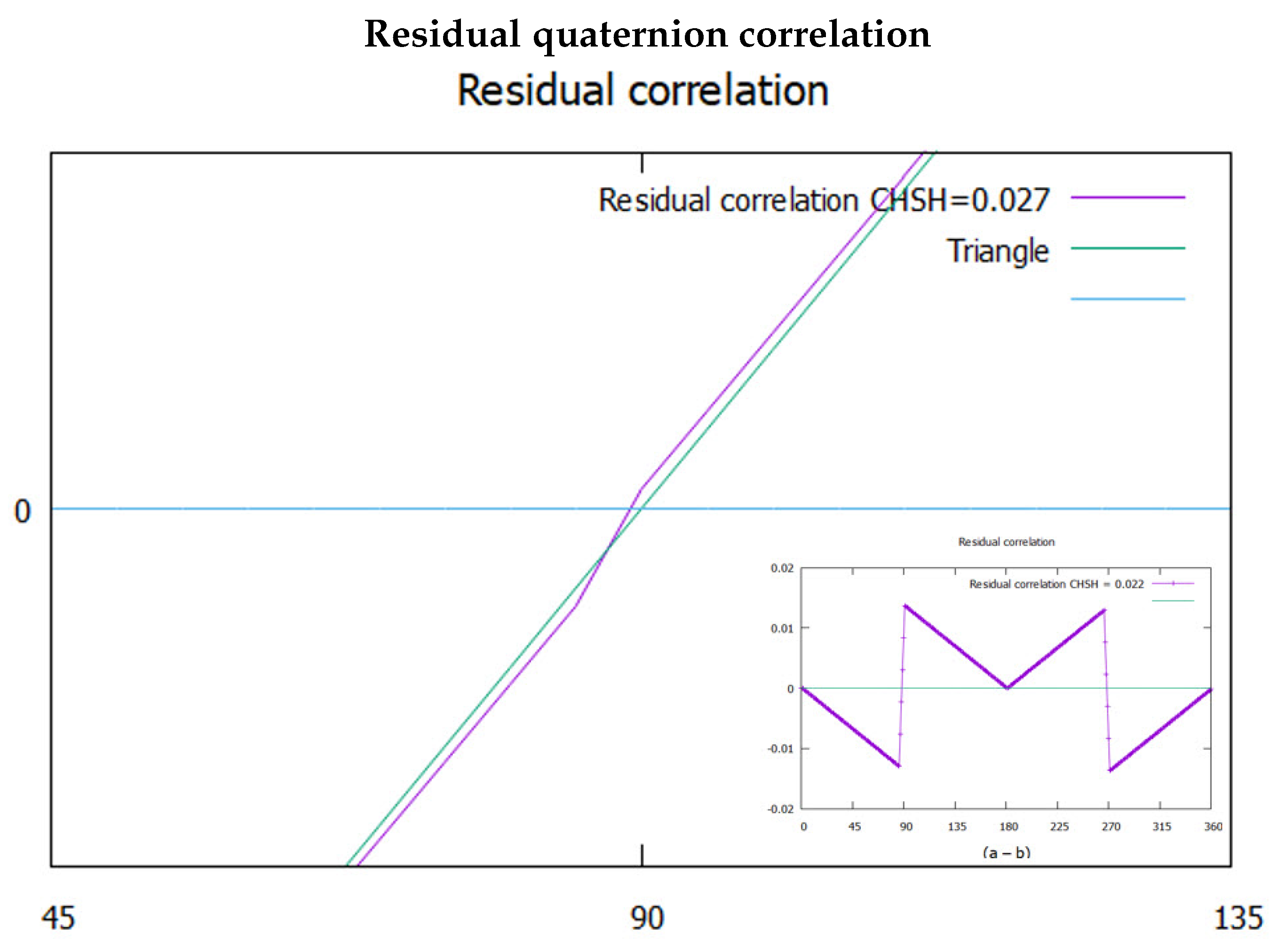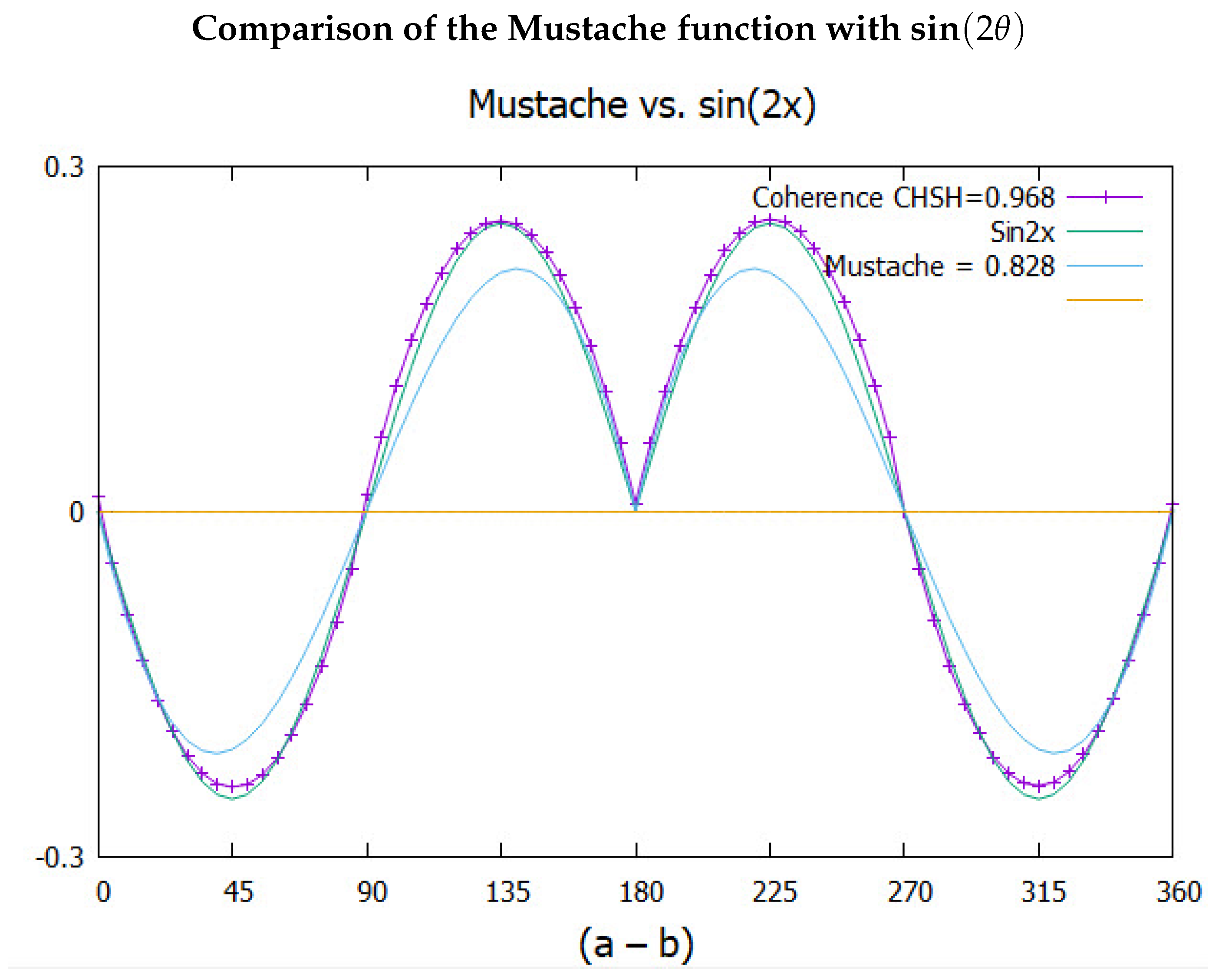Motiavation
As usual we assume that an EPR pair was initially in a singlet state given by
Since coherent states are off-diagonal,
, and these are not displayed in the above equation, we use the spin state operator, [
11], by taking the outer product of Eq.(
1), giving,
The resulting matrix can be represented as the tensor product between the two identity matrices,
and the scalar product between the two Pauli spin vectors. The two diagonal elements of the outer product matrix above describe polarization, whereas the two off-diagonal elements are the coherent terms. The coherent terms are responsible for the entanglement and preclude the product state. If those two coherent states are dropped, then the singlet state becomes a product state,
in terms of the tensor product of the two single particle state operators,
where
. We view these state operators as describing the pure states of single particles rather than a statistical ensemble over similarly prepared EPR pairs. Eventually we average over all the different spin orientations,
, in the simulation. There is no statistical interference between EPR pairs and every pair produces a coincidence event.
Using Eqs.(
2) and (
3) we obtain the EPR correlation from an entangled state as [
6],
Likewise using Eq.(
3) the product state gives,
The basis component,
is chosen to be the usual LFF component
Z, giving the two final cosine terms.
In EPR coincidence experiments, the observed correlation is not consistent with the product state, Eq.(
6) but rather gives the full correlation from in Eq.(
5). One of the many statements of the EPR paradox [
12], is the conclusion that entanglement must be maintained over spacetime. This is justified by Bell’s Theorem, but how such non-local connectivity is maintained is not understood, and defies rational explanation, [
13]. [
14,
15].
In conclusion, if the quantum coherence terms are dropped when an EPR pair separates, the resulting product state does not agree with the experimental results. Including these terms is the purpose of this paper, and we show that they account for the full quantum correlation. That is, the violation is a result of coherence rather than non-local connectivity.
Geometric algebra
The calculations of the correlation given in both Eqs.(
5) and (
6) involve the trace over the dydic,
. This trace is symmetric requiring
.
One of the most fundamental equations from geometric algebra, [
10] expresses a dyadic in terms of the symmetric scalar product and the anti-symmetric wedge product,
Specializing this to the Pauli spin components, we write
in terms of the anti-commutator and the commutator of these components,
. Using the relationship
in terms of the Levi-Civita third rank totally anti-symmetric tensor, requires
in the anti-commutator and
in the commutator. This leads to the well-known relationship between spin components of
Note that this expression is complementary since the dyadic cannot be simultaneously symmetric and anti-symmetric (
i cannot simultaneously be equal and not equal to
j). Only one of the two can occur at any instant.
The anti-symmetric part plays no role in determining the observed spin polarization that depends upon the difference between the two measured spin states,
. Here
is unit vector on the Bloch sphere. Motivated by Eq.(
9), we defined the hyper-helicity, [
6], as a complementary attribute to the coherence,
Using this second rank anti-symmetric and anti-Hermitian operator in the same calculation as given above for the product states, Eq.(
6) generates the missing correlation, [
6],
Of course, added to the product of cosines in Eq.(
6), this correlation fully accounts for the -cosine calculated in Eq.(
5). This suggests the observe violation of BI is a result of hyper-helicity.
The Dirac equation
Here we summerize the results of reference, [
8]. The Dirac equation provides the mathematical basis for spin. If hyper-helicity is an element of reality, it must be consistent with the Dirac equation. Just as Dirac interpreted his four dimensional field as consisting of a matter-antimatter pair of two states each, so should it also give a formal basis for the existence of hyper-helicity.
The Dirac field is represented by the gamma matrices,
, involving time and the three spatial components. The Dirac equation contains no bivector so cannot describe the hyper-helicity. However, a bivector can be introduced by multiplying one gamma matrix by the imaginary number
i chosen to be
. This is the only fundamental change introduced in the theory and the solution follows standard methods, [
16].
As they must, the gamma matrices still anti-commute but the change to the Pauli spin components in the gamma matrices describes spin in terms of
rather than
. By multiplying by
i, the usual spin
symmetry of SU(2), is changed to being a normal subgroup of the quaternion group,
. In contrast to the point particle vector description of Dirac spin, the Q-spin displays structure. Now, rather than three spatial components, there are only two,
. These are two orthogonal Pauli vector components and they give Q-spin a planar 2D structure, (
Figure 1). The bivector is no longer a spatial component, but rather is a time, being the frequency of the helicity. The bivector is perpendicular to the two spatial components and, as now discussed, provides the basis for the hyper-helicity.
Introducing the bivector into the Dirac equation renders it non-Hermitian, [
8]. It’s two solutions,
, are mirror states analogous to Dirac’s matter-antimatter description.
We are considering a free particle, and in an isotropic environment, the two spatial components,
, are indistinguishable, so permuting them with a parity operator
leaves them unchanged. In contrast the bivector is odd to parity,
. This directly shows the two solutions are mirror states which reflect under parity,
, and therefore have no definite parity,[
8] themselves.
However, the two mirror states can be combined to give states that are odd and even to parity,
which leads immediately to the separation of spin spacetime, [
8], into two distinct parts giving: a two dimension Dirac equation for the two spatial components; and a massless Weyl spinor equation for the bivector. The solution to the Weyl equation is a unit quaternion which spins the 2D spatial plane. The 2D spin states are even to parity while those of the quaternion space are odd to parity.
The quaternion version of the Dirac equation justifies the hyper-helicty as a real attribute of spin which is perpendicular to the 2D spin plane along the LFF
Y axis. Taking this as the axis of linear momentum, gives the view in
Figure 1 with helicity spinning that axis.
The two orthogonal spatial components, , are viewed as two spin axes, each carrying a magnetic moment . These are the mirror states. The EPR pairs are in free flight from the source up until they encounter their filters. Free-flight helicity and measured polarization impose complementarity on Q-spin.
There are four internal precessions: the helicity about the axis of linear momentum; the two orthogonal spin axes, each with a magnetic moment of
. In free-flight the two spin
components must couple to give the forth internal motion of Q-spin, with a magnetic moment of
, see (
Figure 3). As mirror states, the two vectors spin oppositely, thereby constructively generating this spin, [
17,
18]. However, there is no spin zero component. Although the two spatial components can spin in either direction, producing both
components, there is no spin zero component because the mirror property would be violated.
In free flight only helicity is manifest since the spinning of the axis of linear momentum averages the resonance spin 1 to zero although it is still present on the particle.
Upon encountering an anisotropic environment due to a filter, the two spin axes, (3,1), are no longer indistinguishable and the mirror property is lost. This leads to the decoupling of Q-spin into its two polarized states of . We observe only one since the helicity is transferred to the aligned spin axis which causes its orthogonal twin to average to zero. This recovers Dirac spin which is a measured spin of . EPR coincidence experiments observe the transition from a boson in free-flight to a fermion upon measurement.
Coherence and polarization are complementary properties of a spin.
Two spin axes on the same particle is a different interpretation than given by Dirac, his being that the mirror states form a matter-antimatter pair.
How the resonant spin decouples depends upon the filter strength and its orientation relative to the resonant spin. This is discussed in the following section.
Preliminaries
Although complementary, as just discussed, both polarization and coherence states simultaneously exist as attributes of spin. However, only one is manifest at any instant. Just as a dyadic Eq.(
9) is the sum of two complementary contributions, so we express Q-spin possessing both properties,
In this section, Q-spin is used to evaluate the correlation between EPR pairs. Initially in a singlet state at the source, they separate and move towards their respective filters. In the process they conserve linear and angular momentum, and helicity, see (
Figure 4). The planes depict the separation process with the middle plane displaying the resonance spins of 1 as anti-parallel for Alice and Bob. Alice’s spin moves right and Bob’s moves left. Their initial orientation at the source is set by the angle
and the axis of linear momentum spins with helicity being either left or right. Bob’s orientation is
to conserve angular momentum. Both spin around the
Y axis in the same direction, thereby maintaining them as anti-parallel in free flight.
Note that Alice and Bob are in opposite frames. Alice is in a right handed frame by the right hand rule and Bob in the left. The two frames are related by complex conjugation, so that whereas they both have the same sense of precession, their helicities are opposite when Bob is viewed from a RH frame.
Since we assume no non-local connectivity between the pairs, we treat only Alice’s spin, with an identical treatment for Bob.
Q-spin correlation
In contrast to the state operator for polarized spin, Eq.(
6), Q-spin has two orthogonal axes giving Alice’s state operator as
in the BFF. The vector is defined by,
From this the expectation values are calculated for the spin axes,
using both the symmetric and anti-symmetric contribution, Eq.(
12),
using
, and the cross products,
Q-spins are denoted by
and the two are coupled in free-flight to define the resonance spin of magnitude 1,
Substituting Eq.(
15) give Q-spin in its BFF,
The BFF is related to the LFF by,
with the filter vector also written in the LFF. Use of these leads to the following expressions,
The second equality separates the quaternion into a product of a geometric quaternion, and a field quaternion.
Correlation in free-flight
From Equation (
15), in the BFF, the resonance spin is oriented by
from the
axis and by
from the
axis. They therefore both coincide along the bisector of their quadrant, which is the position of their Q-spin. This is displayed in (
Figure 5) giving one of the four Q-spins. Different combinations of
give all four components that bisect the quadrants in (
Figure 5). For each specific orientation of the BFF relative to the LFF, a Q-spin can form in any one of the four possible quadrands, and Alice and Bob share opposite quadrants. Once formed, they continue in free-flight after leaving the source and maintain their relative orientations.
Upon separation, Alice and Bob’s spins are anti-correlated by requiring
for Bob. The correlation is defined as the scalar product between the two resonance spins, being the complex conjugations of either. Remaining in the BFF and in the absence of the filters term,
in Eq.(
20), the correlation is given by
The correlation is the sum of the contributions from left and right handed helicity, see Eq.(
3). As expected, after leaving a common source, in free-flight before encountering filters, the correlation between Alice and Bob is -1 consistent with the two spins remaining anti-parallel and anti-correlated.
Interpretation
The second line in Eq.(
20) shows the resonance spin, (
Figure 3), as viewed from the LFF. The first term is its projection, Eq.(
14), onto the laboratory
Z axis, and the second term is the projection onto the LFF
X axis. Each axis has a field quaternion with angle
, and these are shifted between the two axes by
.
Coupling of angular momentum is common in all spectroscopes [
19], including transport properties of gases, [
20,
21]. Coupling of angular momentum depends upon the strength of the applied field relative to the coupling constants. In our case, the resonance spin is stable in free-flight but will eventually decouple as it approaches the filter. At a given distance, the decoupling depends upon the orientation of a spin relative to the filter, and the filter strength relative to the spin coupling strength.
When the orientation of the resonance spin is close to the
or
axes, the spin is more easily polarized than when it lies along the bisected quadrants, see (
Figure 5). Such orientation leads to a product state solution, Eqs.(
6) and (
25).
To visualize the filtering preocess, take (
Figure 5) and imagine Alice and Bob’s filter with the same origin and pointing randomly in any direction. An experiment can randomly set the filters to any angles,
,
and
degrees in the BFF. Next rotate BFF in either direction so all values of
are sampled, and observe how the filters encounter the spins, Dirac spin along
and
and Q-spin along the four bisectors.
There are generally four cases that vary with
relative to the filter direction, which are: Both Alice and Bob’s spins are polarized (pol:pol); Alice’s spin is polarized and Bob’s is a Q-spin (pol:coh); Alice’s spin is coherent and Bob’s is a polarized (coh:pol); and both are coherent Q-spins (coh:coh). The first three cases lead to product states, Eq.(
24). Only the last case gives the coherent contribution that gives the observed violation of BI, Eq.(
20).
With this, we can understand the filter settings in the CHSH inequality that give the maximum correlation and violation of BI. This occurs when the filters at both Alice and Bob are such that both favour Q-spins over the polarized spins. These lie along the bisectors of the quadrants in the BFF. If we choose the relative setting of
to be multiples of
, see (
Figure 5), top right, then we can be sure that when Alice encounters regions of high coherence, then so will Bob. The most favourable
wedge lies between 22.5 and 67.5 degrees. Under these conditions, as the BFF orientation is rotated with the filters so set, then when Alice’s coherent axis lies close to the filter, then so must Bob’s. The maximum correlation for the
S=CHSH inequality is determined by the filter setting that differ by
, as shown in (
Figure 5), and giving,
We do not treat the dynamics of the 2D spin approaching the filter, but if the magnetic moment for each spin axis is , then the resonance spin has a Larmor precession proportional to before it decouples. The Larmor frequency of the resonance spin is twice that of the aligned or polarized spin.
Simulation model
From the discussion above, we distinguish polarization events from coherent events respectively by the presence of the two polarized axes,
and
, or the single axis of the two coupled spins of
of the Q-spin. From the second line in Eq.(
20) the two axes of Q-spin are viewed in the LFF as the superposition of these two axes.
This equation re-written from Eq.(
20), generates all the simulated correlation presented in this paper.
For polarization coincidences, we choose the real part of either axis of Eq.(
27) and simply determine if it spins L (negative) or R (positive) giving a plus or minus click, or vice versa. We use this to calculate the correlation due to the polarizations.
For the coherence part of the simulation, the two field axes, one at Alice and the other at Bob, form the
wedge and this more or less bisects a Q-spin. When the wedge is off-set to the left or right, one axis will be closer to the field direction than the other. The closer one will eventually become polarized. It is important to know which axis will align because they carry opposite spin. It is difficult to imagine that Q-spin could pass the filter intact. Certainly one of the two spin
axes will become polarized as the filter field increases. We therefore first determine which axis lies closer to the field vector by writing the real parts Eq.(
20) as
and determine the larger axis as the one that will become polarized. With a Larmor precession double that of a polarized spin, the filter angle is doubled to
in Eq.(
28). From this equation we assume that the larger axis will finally align with the filter,
The click events from a polarized spin are determine if the imaginary part of Eq.(
27) is positive or negative. In this case, since the larger axis becomes a polarized spin
, the Larmor precession reverts to that of a spin
so
drops the 2.
In the simulation, these relations are used to model the correlation from both polarization and coherence.
Simulation results
The FORTRAN and C code that determines clicks from polarized states and coherent events uses the above algorithms.
The results are given in Figure (
Figure 6). The simulated correlation from either polarization axis gives the polarization as the triangle. The mustache coherence which depends on the couplng of the two axes into one axis, given by (
Eq.(
27)), is shown in same figure and gives a CHSH = 0.968. The simulation gives more correlation than from quantum theory, CHSH = 0.828
The full simulated plot is the sum of the simulated polarization and the simulated coherence. These give a combined CHSH value of 2.995. Note that this CHSH value is a sum of polarization, 2.027 and coherence, 0.968].
The theoretical CHSH value for polarizations is 2, whereas in (
Figure 6) it is 2.027. There is residual correlation that remains as shown in (
Figure 7). A cross over occurs close to the horizontal axis. It is hardly discernible. Considering it might be an artifact, various tests did not remove it. This has similar symmetry to the mustache coherence and supports this to be a real feature in the model. From the inset in (
Figure 7), there are two discontinuities at
and
. Removing these features by moving the middle triangle down gives an inverted triangle, but also gives a CHSH value of zero. The discontinuities, therefore, are necessary for the residue to be physical. We assert this residual contribution to coherence is due to correlation in the polarization states. If confirmed, the polarization exceeds BI, ([
7]), by a small amount and violates his theorem ([
22].
The CHSH value of 2.995 is larger than that expected from quantum theory . In the discussion we argue the 2.995 value results from the way the simulation models the coherences.
